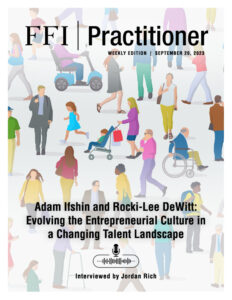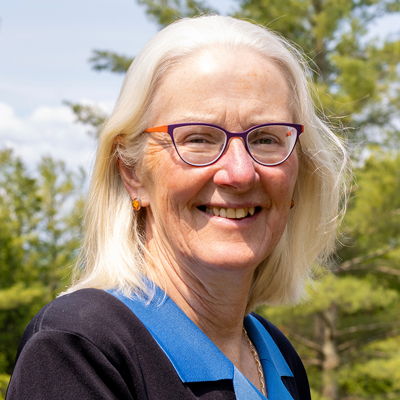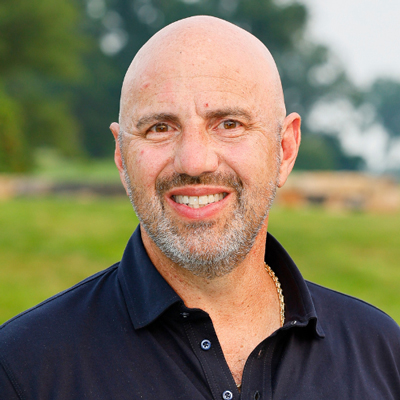
View this edition in our enhanced digital edition format with supporting visual insight and information.
FFI Practitioner is pleased to host Adam Ifshin, CEO of DLC Management, and Rocki-Lee DeWitt, Professor of Management in the Grossman School of Business at the University of Vermont, in a conversation based on their upcoming session at the FFI Global Conference in New York, October 25-27. In this podcast, hosted by Jordan Rich, they discuss “Evolving the Entrepreneurial Culture in a Changing Talent Landscape.”
Podcast Transcript
Jordan Rich (JR): Welcome to the FFI Practitioner podcast. Today we are pleased to bring you a conversation with Adam Ifshin, CEO of DLC Management, and Rocki-Lee DeWitt, Professor of Management in the Grossman School of Business at the University of Vermont. At the 2023 global conference, Adam and Rocki will present the session, “Evolving the Entrepreneurial Culture in a Changing Talent Landscape.” Adam, why is this such an important topic at this time?
Adam Ifshin (AI): I came at this from two areas. My formal undergraduate study was in economic demography. I had been aware of certain emerging trends in demographics and immigration policy that were negatively impacting on a macro level the availability of skilled and talented workforces in many parts of the American economy for years. It was only growing as Baby Boomers aged out of the workforce, other industries became, perhaps, the darling of young people coming out of college. The number of college graduates was going to start to shrink pretty dramatically due to a decline in the total fertility rate twenty or so years prior.
At the same time, I was growing a business that for a decade grew at about seventy percent a year compounded, and in a business that was not particularly sought after for young talent. We saw the aging of the experiential cohort in the industry. Those things all collided together hard starting in the mid-2010s, between calling off the IPO that we had planned to do, we had doubled the size of the business between 2005 and 2010. And we had doubled the size of the business again between 2011 and about 2017.
There’s a limit to how much you can get in terms of better experience, retention of high-quality performing people, and productivity enhancements. There are fundamental laws of diminishing returns at some point from those levers, and we had an aging-out cohort, on top of that, in certain roles. And the growth, which was the imperative for me as the entrepreneur at the helm of the ship, came first, and I realized that we would have to take a radically different view to talent if we were going to be able to source the caliber of people we wanted to grow the business and to achieve the financial success that growth, from our perspective, afforded us an opportunity to access.
So I’ve been looking at this for a very long time, the trends have been there for a very long time, but the exigency in my own business, which has been there for probably the better part of a decade now, only grows both the more successful the business is, the more those demographic trends accelerate and dominate. And it’s hard not to answer the question without understanding the impact that COVID had on the demographic trends. You saw a whole bunch of Baby Boomers, for whom sixty-five was the new fifty, who wanted to work and were really talented team members. But for many of them, COVID [prompted them to say], “Wait a minute—why am I doing this? I have enough money, I’ve planned for my retirement. Why am I taking the risk of continuing to work?” In my view, that had a large role in causing that wage spike we saw coming out of COVID in 2021 and ’22, and all the things that went along with it—wage spiral, inflation, the “Great Resignation,” “quiet quitting,” all of the pastiche terms that the mainstream business media put on it. I think that we were way ahead of this curve, thank goodness, but I think it’s a core business challenge for any business in the United States today.
JR: Let’s turn to Rocki. This encompasses a wide swath of businesses and family businesses, right? We’re not just limiting it to one particular industry or one particular mode of employment, are we?
Rocki-Lee DeWitt (RD): No, we’re not at all. I think the thing that Adam drew attention to that is so important is that people are finding other sorts of jobs that are more interesting. The growth in the digital realm and that kind of work was attracting individuals, yet predominant employers are often in the business of making things, servicing things, and have real cash flow as opposed to a burn rate.
AI: I think also, Jordan—we hear various numbers all the time, but there’s no doubt that family businesses represent a substantial part of the macro-GDP and the American economy. I think it would be overly simplistic to assume that they don’t face the same kinds of challenges that more public, institutionalized businesses do. One of the things that I had sensed over time, and I’m sure Rocki will go into more depth about this later, is that there is an intensity of focus—for very good reasons—in the family business consultancy world and academic world on “family business primary issues.” But sometimes, there are overwhelming trends in the marketplace that have to be finessed into those other, equally important issues because there is significant interplay. They can have significant ramifications on those primary family business issues if you don’t know how to navigate them, particularly around building what I believe is the most important thing that any entrepreneur needs to do, and any CEO needs to do in American business today, which is to build a world-class, team-oriented, holistic, team-focused culture, first and foremost.
JR: Adam, tell us more about how your company transitioned to accommodate this issue.
AI: It took a long time. I’m a big believer in taking lots of small chances. I knew that this could not be solved by simply paying one cohort of people more money. Upping the retention rate alone wouldn’t do it. A better snack bar wouldn’t do it. A total remote work policy wouldn’t do it. Ultimately, I looked at my senior leadership team—and by the way, COVID provided us an opportunity to dig in and do this, first remotely and then socially distanced on my back patio, where we met incessantly about this—but what we sought to do and what we’ve achieved, is we built a culture that’s a people-first culture. In many family businesses, the non-family members take that to mean that it is a family-first culture. We built a people-first culture. How did we do that? We did lots of different things. We invested an insane amount of time and money into developing young talent. We knew from the demographics inside our industry that not enough young people were coming into our industry, and our industry was aging. I was in leadership of our trade association, I had all that demographic data which was not public, and I could see it in my own business. We hired someone solely to hire, recruit, train, and identify young people coming out of predominantly undergraduate business schools but also undergraduate liberal arts programs at schools that we thought we could afford people from and where people weren’t necessarily thinking that they were going on to an Ivy League graduate education or to Wall Street. We invested heavily—whether that was at UVM, SUNY Binghamton, Pace University, Monmouth in New Jersey, all over—University of Wisconsin, Kelley School at Indiana—we went out and we sought to leverage our happiest employees at their alma maters and in other ways to get into places. We built training programs across our largest disciplines, which include accounting, property management, leasing (which is our sales function), and financial analytics. We built training programs—even though we’re only about 130 people today and we were probably only about eighty people when we started this. We took the time and made the effort to build and invest in those.
The second thing was we sought to build a world-class, twenty-first century culture. Nobody says “employee” here; we only have team members. You don’t get hired—you either get drafted if you’re coming out of school or you get signed as a free agent if you’re coming in with an experiential base. We said to the leadership of the company, “You need to think about yourself as building what could be very transient in today’s day and age—workforce.” How do you make it a little less transient? Find me the guy who always gets signed to be the sixth man on a great head coach’s basketball team. You need to find people who care about those things. It’s not just about money, it’s not just about perks. Everybody needs to have the belief themselves—perception is reality—that they can have a great career here. Otherwise, they’re going to be susceptible to an incredibly fluid, incredibly transparent job market. You leave here, you end up taking a job somewhere else. Here, the imperative is on our leadership team to give you the opportunity to have a great career. That’s really the core of the culture.
RD: Being side-by-side with [Adam] while he was doing this and at the same time being at an academic institution and watching these kinds of generational changes of students coming to school, coming out of school, there are still people, given the changes in employment in the world, who are going to be very transactionally, self-centered-oriented. The challenge for an employer or an organization or entity is to identify the people who fit with what their organization is about and what they’re trying to achieve. In Adam’s organization, knowledge, experience, and how to do deals really matter. A lot of organizations have that same thing. You have people who are in boundary-spanning roles, who have repeat customers and repeat suppliers, and you need that enduring base of talent to make the organization go. Your piece is finding individuals who relish that kind of responsibility, that kind of accountability, that kind of contribution to the organization. That means you need to spend more time and more effort on figuring out who individuals are and what makes their brains work the way they do. Hence the role of internships and ways of having individuals suggest other individuals who are like them for employment or teammate opportunity.
JR: The idea of going after talent, not waiting for talent to come to you, seems to be part of this theme.
AI: That’s a huge part of the theme. I was motivated to go do things like teach with Rocki and others at UVM and at other places, where I’ve been fortunate enough to be asked to guest lecture and teach. I did it because I found it enlightening, it was a learning opportunity for me as well, but make no mistake about it, I was always on the lookout for talent. And I am constantly on the lookout for talent. Our leadership cohort here is probably solidly a decade younger than the average age of all of our competitive companies in this space, whether they be public or private. And I would suspect—and it’s very hard to find data on this, so this is an anecdotal comment, admittedly—that for family businesses in my space, the average age of my leadership cohort is probably two decades younger than the family businesses, which tend to be, at least in our business, more traditional, more hierarchical, less likely to experiment or think about taking a more aggressive view about cultural development and career development for non-family members.
One of the things that I saw very clearly in the global financial crisis—I had three adolescents during the financial crisis, and I saw them and all of their friends. What we have now is a generation and a half in the American workforce who have a fundamentally different view of the social contract between an employer and an employee. The global financial crisis broke that perception, because many people who were then adolescents to young adults, whose parents had been careerists at a single company or perhaps just a couple of places—IBM, GE, United Technologies, just to quote a few in areas where we do business.
All of the sudden, Mom or Dad or both are out of work in 2009, because they had spent their entire career at Lehman Brothers or Bear Stearns, and all of the sudden [their children] had to borrow the money if they wanted to go to college, Mom and Dad are not going to be able to help [them] with that. [They] watched Mom or Dad out of work for two, three, four years because they [were] in their late forties or early fifties and suddenly [were] not that attractive to the labor market. Those parents went from teaching their children, “Go to work at a great company, and that company is going to take care of you, will help you take care of your career,” to “Don’t trust them. Don’t trust them with your career. Learn from them and move on.” Breaking that cycle requires an extraordinary cultural and leadership commitment by an institution or an organization that has to be very forward-thinking. We still fight that every day, and most of the talent that comes to us that’s young and stays, comes from more unconventional backgrounds as a result.
JR: Before we close out, let me ask you both to comment on this, and this should be a perfect way to wrap: succession is something that should be at the top of mind for every family business, all the time, because it’s a fact of life, but wouldn’t we want to partner succession with talent-mining, because that is equally as important?
RD: I’ve spent quite a bit of time around the succession literature, succession experience from back in the late seventies with the work I was doing in Ohio. To me, it’s always been [that] talent was the question, succession was just one of the levers that was getting pulled around talent. That’s my perspective, but I recognize that that perspective is not common, so I feel like I’m having to go back and play that old 33 RPM record that I played back in the late seventies again in today’s environment. The demographic circumstances as well as what I’ll call the cultural changes in society [make that advice] less likely to fall on deaf ears now.
AI: We have a first-hand situation: I have three children. One decided, my oldest, after her grandfather passed away, to come into the business. But we had very candid and explicit conversations in advance of her coming in. She was extremely candid with me: 1) she didn’t know that she ever wanted to run the business, 2) she didn’t know if she would ever be qualified to run the business. Her rationale for coming into the business was that she wanted to be qualified to understand the business in all of its aspects such that, God forbid something happen to myself and her mother, she would be in a position to form her own opinions and keep her own counsel with respect to investment decisions.
She did not come in saying, “I want to run it.” She did not come in with that traditional, oldest sibling, hierarchical, primogeniture view. That has opened the door to dovetail and mesh incredibly well with what we’re talking about, because if you’re going to give everybody the opportunity to have a career and that defines your culture, that better apply to both family and non-family members. I have a very clear understanding with my daughter that she may not be the CEO here one day. There may be somebody more qualified here now, or who may come into the organization at a later date. What the organization is going to do is make the best decision for the organization, and it will figure out how to dovetail that with the best decision for the family. But if you don’t make the best decision for the organization, in my view that is going to lead to some unhappy, difficult conversations among the family at some point in the future. I think that there is a way to mesh these two together, but I think it’s critically important that the people who have so much to say, in many good ways, to family business leaders and to families with multi-generational family businesses, that they have to consider this and factor this into their thinking. At least historically, much of the thinking has been more family-centric than it has been leadership-centric.
JR: The question is, basically, how can family enterprise advisors guide their clients through the changing talent landscape. What simple advice would you like to impart?
RD: It’s simple—most family business advisors are working with [John] Davis’s three-circle model. They’re heavily focused on family and ownership and a bit light on the employee bubble. We’re trying to draw attention to employment and the work world going forward. Like any good advisor, you start with yourself, first reflect on your own work history, where you’ve worked, why you’ve worked, and how you do it. How does that inform the assumptions you make about how people work and, to put it brashly, do you have a clue what’s going on out there? Second, once you’ve familiarized yourself with different models of employment, work with your existing clients to review and plan for how over the course of the next decade they will access and develop the talent they need. That is family talent, who participates in the work of the organization, family who participates in the governance of the family’s wealth, and non-family individuals who can participate as workers, owners, and even members of an extended family. Some [of those families] may have engaged us in an advisory role. If they don’t voluntarily tell us about their approach to talent, don’t be reticent. Ask them about how they’re viewing people in the organization, where they’re coming from, how they’re going to get developed, how they’re going to get compensated. Insert yourself into the conversation, but recognize you may need somebody on your advisory team who is more attuned to hearing that employment sphere as they work with an organization.
AI: To use the Davis model as an anchoring point, the reality is that overlap between family and senior non-family leaders—that intersection area in the model—is much bigger than it appears in an equal-weight model, in our view. The demographic trends that are going on are forcing, in our view, the need for advisors to think about that space intensely, innovatively, shot through the lens of, if you can’t figure out that intersection, your ability to maximize the success—however you want to define “success,” EBITA, cash flow, growth, enterprise value—of the family enterprise is not going to be maximized, in our view. It is incredibly important that advisors spend even more time in expanding the thought bubble that goes in that overlap.
JR: Thank you to Adam Ifshin and Rocki-Lee DeWitt for our discussion about the effect of the changing talent landscape on entrepreneurial culture. To learn more about FFI membership and the upcoming October conference in New York, go to www.ffi.org. This is Jordan Rich. Thank you for listening!
About the Contributors

Rocki-Lee DeWitt, PhD, is a Professor of Management in the Grossman School of Business at the University of Vermont. She is familiar with generational shifts in the interests, motives, and attitudes in the talent landscape through almost 40 years of work advising undergraduate and graduate students. Her scholarship and advising addresses corporate restructuring, turnaround management, downsizing, and unanticipated leadership changes in family business, and the effects of those events on entrepreneurial pursuits and innovation. She can be reached at Rocki.DeWitt@uvm.edu.

Adam Ifshin is a serial entrepreneur from the age of 19. Now in his fifth decade of running his own businesses, he is the CEO and Co-Founder of DLC Management Corp. and affiliates. DLC is one of the nation’s largest privately held owners of open-air shopping centers with over 120 team members, $2.2B in assets, and a 32-year history of delivering superior risk adjusted returns for their investors and partners. He is recognized as a thought leader on the intersection of entrepreneurship, real estate, and family business. With Rocki-Lee DeWitt, he is the co-author of a case study on the decision to pull DLC’s IPO, which appears in the Case Research Journal.
Interviewer: Jordan Rich is celebrating a quarter century at one of America’s top legacy radio stations, interviewing thousands of celebrities, authors, actors, and interesting personalities throughout his career. Jordan is co-owner of Chart Productions Inc. and teaches voice-over acting. His main focus these days is in podcast creation and production, featuring conversations with the world’s most creative people.

View this edition in our enhanced digital edition format with supporting visual insight and information.





